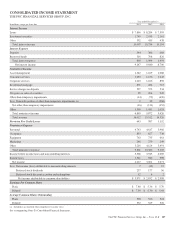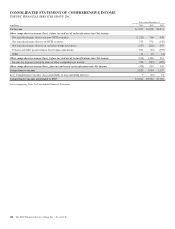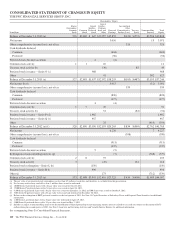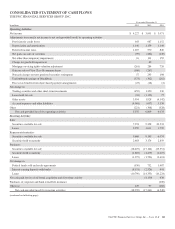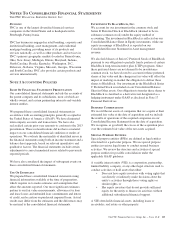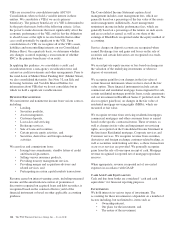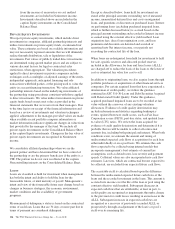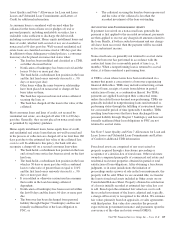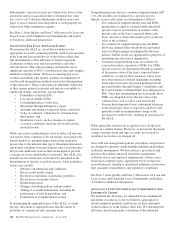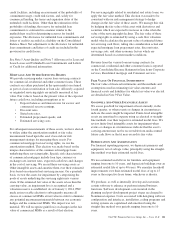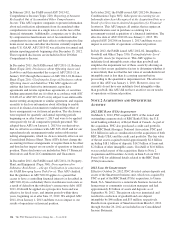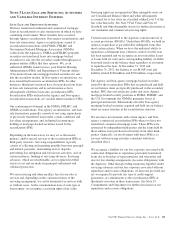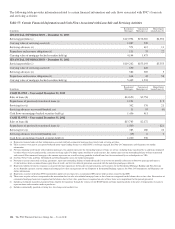PNC Bank 2013 Annual Report Download - page 134
Download and view the complete annual report
Please find page 134 of the 2013 PNC Bank annual report below. You can navigate through the pages in the report by either clicking on the pages listed below, or by using the keyword search tool below to find specific information within the annual report.from the income of an investee on cost method
investments are included in Noninterest income.
Investments described above are included in the
caption Equity investments on the Consolidated
Balance Sheet.
P
RIVATE
E
QUITY
I
NVESTMENTS
We report private equity investments, which include direct
investments in companies, affiliated partnership interests and
indirect investments in private equity funds, at estimated fair
value. These estimates are based on available information and
may not necessarily represent amounts that we will ultimately
realize through distribution, sale or liquidation of the
investments. Fair values of publicly traded direct investments
are determined using quoted market prices and are subject to
various discount factors for legal or contractual sales
restrictions, when appropriate. The valuation procedures
applied to direct investments in private companies include
techniques such as multiples of adjusted earnings of the entity,
independent appraisals, anticipated financing and sale
transactions with third parties, or the pricing used to value the
entity in a recent financing transaction. We value affiliated
partnership interests based on the underlying investments of
the partnership using procedures consistent with those applied
to direct investments. We value indirect investments in private
equity funds based on net asset value as provided in the
financial statements that we receive from their managers. Due
to the time lag in our receipt of the financial information and
based on a review of investments and valuation techniques
applied, adjustments to the manager-provided values are made
when available recent portfolio company information or
market information indicates significant changes in value from
that provided by the manager of the fund. We include all
private equity investments on the Consolidated Balance Sheet
in the caption Equity investments. Changes in the fair value of
private equity investments are recognized in Noninterest
income.
We consolidate affiliated partnerships when we are the
general partner and have determined that we have control of
the partnership or are the primary beneficiary if the entity is a
VIE. The portion we do not own is reflected in the caption
Noncontrolling interests on the Consolidated Balance Sheet.
L
OANS
Loans are classified as held for investment when management
has both the intent and ability to hold the loan for the
foreseeable future, or until maturity or payoff. Management’s
intent and view of the foreseeable future may change based on
changes in business strategies, the economic environment,
market conditions and the availability of government
programs.
Measurement of delinquency status is based on the contractual
terms of each loan. Loans that are 30 days or more past due in
terms of payment are considered delinquent.
Except as described below, loans held for investment are
stated at the principal amounts outstanding, net of unearned
income, unamortized deferred fees and costs on originated
loans, and premiums or discounts on purchased loans. Interest
on performing loans (excluding purchased impaired loans,
which is further discussed below) is accrued based on the
principal amount outstanding and recorded in Interest income
as earned using the constant effective yield method. Loan
origination fees, direct loan origination costs, and loan
premiums and discounts are deferred and accreted or
amortized into Net interest income, over periods not
exceeding the contractual life of the loan.
When loans are redesignated from held for investment to held
for sale, specific reserves and allocated pooled reserves
included in the Allowance for loan and lease losses (ALLL)
are charged-off to reduce the basis of the loans to the lower of
cost or estimated fair value less cost to sell.
In addition to originating loans, we also acquire loans through
portfolio purchases or acquisitions of other financial services
companies. For certain acquired loans that have experienced a
deterioration of credit quality, we follow the guidance
contained in ASC 310-30-Loans and Debt Securities Acquired
with Deteriorated Credit Quality. Under this guidance,
acquired purchased impaired loans are to be recorded at fair
value without the carryover of any existing valuation
allowances. Evidence of credit quality deterioration may
include information and statistics regarding bankruptcy
events, updated borrower credit scores, such as Fair Isaac
Corporation scores (FICO), past due status, and updated loan-
to-value (LTV) ratios. We review the loans acquired for
evidence of credit quality deterioration and determine if it is
probable that we will be unable to collect all contractual
amounts due, including both principal and interest. When both
conditions exist, we estimate the amount and timing of
undiscounted expected cash flows at acquisition for each loan
either individually or on a pool basis. We estimate the cash
flows expected to be collected using internal models that
incorporate management’s best estimate of current key
assumptions, such as default rates, loss severity and payment
speeds. Collateral values are also incorporated into cash flow
estimates. Late fees, which are contractual but not expected to
be collected, are excluded from expected future cash flows.
The accretable yield is calculated based upon the difference
between the undiscounted expected future cash flows of the
loans and the recorded investment in the loans. This amount is
accreted into income over the life of the loan or pool using the
constant effective yield method. Subsequent decreases in
expected cash flows that are attributable, at least in part, to
credit quality are recognized as impairments through a charge
to the provision for credit losses resulting in an increase in the
ALLL. Subsequent increases in expected cash flows are
recognized as a recovery of previously recorded ALLL or
prospectively through an adjustment of the loan’s or pool’s
yield over its remaining life.
116 The PNC Financial Services Group, Inc. – Form 10-K



